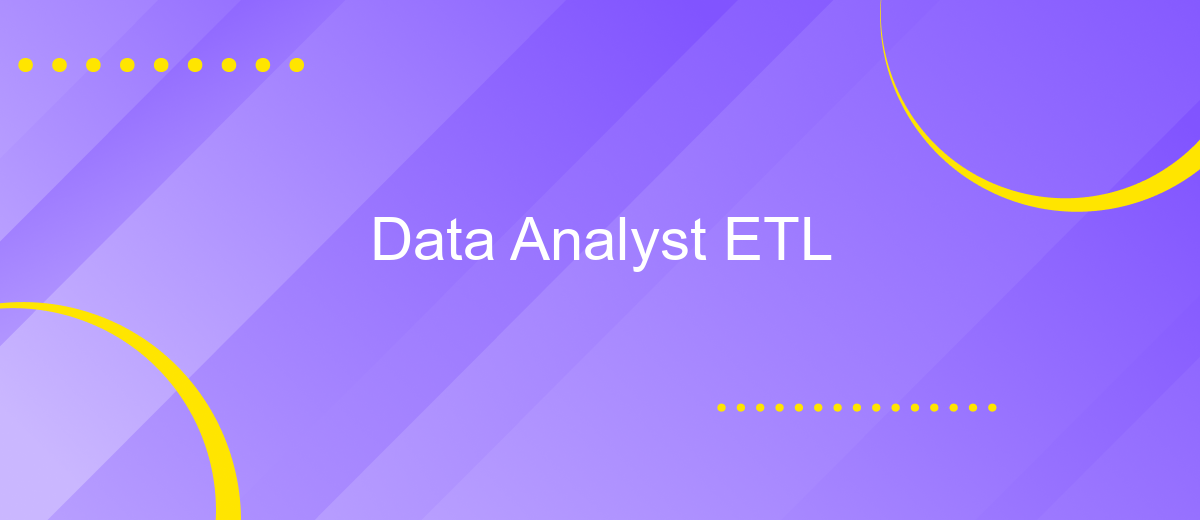Data Analyst ETL
In today's data-driven world, the role of a Data Analyst specializing in ETL (Extract, Transform, Load) processes is more critical than ever. These professionals are responsible for gathering raw data, transforming it into meaningful insights, and loading it into data warehouses. This article delves into the essential skills, tools, and techniques that make ETL Data Analysts indispensable in modern business environments.
Introduction
Data Analyst ETL (Extract, Transform, Load) is a crucial process in the field of data analytics and business intelligence. It involves extracting data from various sources, transforming it into a suitable format, and loading it into a data warehouse or other storage systems. This process ensures that data is clean, consistent, and ready for analysis, enabling organizations to make data-driven decisions.
- Extract: Collect data from multiple sources such as databases, APIs, and flat files.
- Transform: Clean, filter, and aggregate data to meet business requirements.
- Load: Store the transformed data into a target database or data warehouse.
Effective ETL processes are essential for maintaining data integrity and accuracy. Tools like ApiX-Drive can simplify the integration of various data sources, automating the extraction and loading phases. By leveraging such services, businesses can streamline their ETL workflows, reduce manual errors, and ensure timely data availability for analysis.
ETL Process Overview

The ETL (Extract, Transform, Load) process is a crucial component in data analysis, responsible for extracting data from various sources, transforming it into a suitable format, and loading it into a data warehouse or other storage systems. This process ensures that data is accurate, consistent, and ready for analysis. Typically, ETL involves several steps, including data extraction from databases, APIs, or flat files, data cleaning and transformation to ensure quality and consistency, and finally, loading the transformed data into a destination system for further analysis.
One of the key challenges in the ETL process is integrating data from disparate sources, which can be time-consuming and complex. Tools like ApiX-Drive can simplify this integration by providing a seamless way to connect different data sources and automate data transfers. ApiX-Drive allows users to set up integrations without coding, making it easier to manage and streamline the ETL process. By leveraging such tools, organizations can ensure a more efficient and reliable ETL workflow, ultimately enhancing their data analysis capabilities.
Data Analyst ETL Components

Data Analyst ETL components are crucial for effectively managing and analyzing large datasets. These components ensure that data is extracted, transformed, and loaded efficiently, enabling accurate insights and decision-making.
- Data Extraction: This step involves retrieving data from various sources such as databases, cloud services, and APIs. Efficient extraction ensures that the data is up-to-date and relevant.
- Data Transformation: During this phase, the extracted data is cleaned, normalized, and formatted to meet the analytical requirements. This step may involve filtering, aggregating, and enriching the data.
- Data Loading: The final step involves loading the transformed data into a data warehouse or other storage solutions for analysis. This ensures that the data is accessible for querying and reporting.
Tools like ApiX-Drive can significantly streamline the ETL process by automating the integration and data transfer between various platforms. This service simplifies the setup of data pipelines, ensuring that data flows seamlessly from source to destination, thus enhancing the efficiency and accuracy of data analysis.
ETL Best Practices

Implementing ETL (Extract, Transform, Load) processes efficiently is crucial for data analysts to ensure data integrity and performance. Adhering to best practices can significantly improve the reliability and scalability of your ETL workflows.
First, always validate your data at each stage of the ETL process to catch errors early. This helps in maintaining data quality and ensures that only accurate data is loaded into the target system. Additionally, consider automating your ETL processes to reduce manual intervention and minimize the risk of human error.
- Use incremental data loading to handle large datasets efficiently.
- Implement robust error handling and logging mechanisms.
- Optimize transformations to minimize processing time.
- Regularly monitor and maintain ETL jobs to ensure continuous performance.
- Utilize integration tools like ApiX-Drive to streamline data extraction from various sources.
By following these best practices, you can create ETL processes that are not only efficient but also scalable and resilient. Leveraging tools like ApiX-Drive for automating integrations can further enhance the efficiency and reliability of your ETL workflows.


Conclusion
The role of a Data Analyst in the ETL process is crucial for transforming raw data into actionable insights. By efficiently extracting, transforming, and loading data, analysts ensure data quality and consistency, which are vital for accurate analysis and reporting. This meticulous process allows organizations to make informed decisions and drive strategic initiatives based on reliable data.
Moreover, integrating various data sources can be streamlined using services like ApiX-Drive, which facilitate seamless data flow between platforms. By leveraging such tools, Data Analysts can automate repetitive tasks, reduce the risk of errors, and focus on more complex analytical challenges. Ultimately, mastering ETL processes and utilizing integration services empowers Data Analysts to deliver valuable insights, driving business growth and innovation.
FAQ
What is ETL in the context of data analytics?
Why is ETL important for data analysts?
What skills are essential for a Data Analyst working with ETL?
How can ETL processes be automated?
What are some common challenges faced during ETL processes?
Time is the most valuable resource in today's business realities. By eliminating the routine from work processes, you will get more opportunities to implement the most daring plans and ideas. Choose – you can continue to waste time, money and nerves on inefficient solutions, or you can use ApiX-Drive, automating work processes and achieving results with minimal investment of money, effort and human resources.

